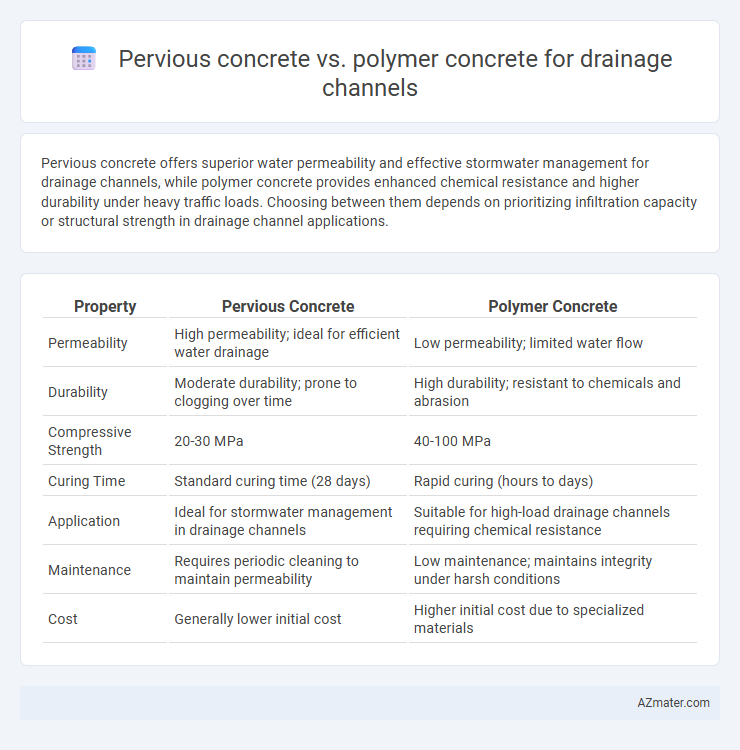Pervious concrete offers superior water permeability and effective stormwater management for drainage channels, while polymer concrete provides enhanced chemical resistance and higher durability under heavy traffic loads. Choosing between them depends on prioritizing infiltration capacity or structural strength in drainage channel applications.
Table of Comparison
| Property | Pervious Concrete | Polymer Concrete |
|---|---|---|
| Permeability | High permeability; ideal for efficient water drainage | Low permeability; limited water flow |
| Durability | Moderate durability; prone to clogging over time | High durability; resistant to chemicals and abrasion |
| Compressive Strength | 20-30 MPa | 40-100 MPa |
| Curing Time | Standard curing time (28 days) | Rapid curing (hours to days) |
| Application | Ideal for stormwater management in drainage channels | Suitable for high-load drainage channels requiring chemical resistance |
| Maintenance | Requires periodic cleaning to maintain permeability | Low maintenance; maintains integrity under harsh conditions |
| Cost | Generally lower initial cost | Higher initial cost due to specialized materials |
Introduction to Drainage Channel Materials
Pervious concrete and polymer concrete serve critical roles in drainage channel construction, offering distinct advantages based on permeability and durability. Pervious concrete excels in managing stormwater infiltration, reducing runoff by allowing water to pass through its porous structure, making it ideal for sustainable urban drainage systems. Polymer concrete provides enhanced chemical resistance and high mechanical strength, suitable for channels exposed to aggressive environments and heavy loads, ensuring long-term structural integrity.
Overview of Pervious Concrete
Pervious concrete is a highly porous material designed to allow water to pass through, making it ideal for drainage channels in urban environments where stormwater management is crucial. Its open-graded structure typically consists of coarse aggregates, cement, and minimal fine aggregates, enabling rapid infiltration and reducing surface runoff. Compared to polymer concrete, pervious concrete offers enhanced permeability and sustainable water management but may require more frequent maintenance to prevent clogging in drainage systems.
Overview of Polymer Concrete
Polymer concrete consists of a polymer binder combined with aggregates, offering superior chemical resistance and high tensile strength compared to traditional cement-based materials. It demonstrates excellent durability and low permeability, making it highly effective for drainage channels exposed to aggressive chemicals and fluctuating water flow. With rapid curing times and enhanced structural integrity, polymer concrete is ideal for ensuring long-lasting performance in demanding drainage applications.
Permeability and Drainage Efficiency
Pervious concrete offers high permeability due to its interconnected void structure, allowing rapid water infiltration ideal for effective drainage channel applications. Polymer concrete exhibits lower permeability but provides enhanced chemical resistance and durability, making it suitable for channels exposed to harsh environments or aggressive chemicals. Selecting between pervious and polymer concrete depends on prioritizing either maximum drainage efficiency or long-term structural resilience in drainage systems.
Strength and Durability Comparison
Pervious concrete offers high permeability and adequate compressive strength typically ranging between 15 to 30 MPa, making it suitable for effective stormwater drainage while supporting light to moderate loads. Polymer concrete exhibits superior mechanical strength, often exceeding 50 MPa, and enhanced durability due to its chemical resistance and low permeability, which prevents water infiltration and reduces freeze-thaw damage in drainage channels. The higher tensile strength and abrasion resistance of polymer concrete extend the lifespan of drainage channels, especially in aggressive environmental conditions compared to pervious concrete.
Installation and Maintenance Requirements
Pervious concrete used in drainage channels requires careful installation to ensure proper porosity and prevents clogging, involving thorough compaction and controlled curing to maintain high permeability. Polymer concrete offers faster installation due to its self-leveling properties and quick curing times, reducing downtime in drainage systems. Maintenance for pervious concrete involves periodic vacuuming to remove sediments that block pores, while polymer concrete demands minimal upkeep thanks to its chemical resistance and dense structure that prevents debris buildup.
Environmental Impact and Sustainability
Pervious concrete enhances environmental sustainability by allowing water to permeate through its porous structure, reducing stormwater runoff and promoting groundwater recharge, which helps mitigate urban flooding and erosion. Polymer concrete offers superior chemical resistance and durability, extending the lifespan of drainage channels and reducing maintenance frequency, though its production involves synthetic resins with higher carbon footprints. Selecting pervious concrete supports natural water cycle restoration, while polymer concrete contributes to long-term infrastructure resilience, making both materials valuable for eco-friendly drainage solutions based on project-specific environmental priorities.
Cost Analysis: Pervious vs Polymer Concrete
Pervious concrete typically offers a lower initial material cost compared to polymer concrete, making it a more budget-friendly option for drainage channels. Polymer concrete, while having a higher upfront cost, provides enhanced durability and chemical resistance, potentially reducing long-term maintenance and replacement expenses. When evaluating total lifecycle costs, polymer concrete can be more cost-effective in environments with aggressive exposure or high traffic demands.
Best Applications for Each Material
Pervious concrete excels in drainage channels requiring rapid water infiltration and stormwater management, making it ideal for urban areas aiming to reduce runoff and recharge groundwater. Polymer concrete is best suited for drainage channels exposed to aggressive chemicals, heavy loads, and extreme weather, as its chemical resistance and high strength provide long-term durability. Selecting pervious concrete benefits permeability-focused applications, while polymer concrete is preferred for structural and chemical resilience needs.
Conclusion: Choosing the Right Concrete for Drainage Channels
Pervious concrete offers superior water permeability, making it ideal for effective drainage channels that reduce surface runoff and promote groundwater recharge. Polymer concrete provides enhanced chemical resistance and durability in aggressive environments, extending the lifespan of drainage infrastructure under harsh conditions. Selecting the right material depends on site-specific factors such as hydraulic requirements, environmental exposure, and maintenance expectations to ensure optimal performance and longevity.

Infographic: Pervious concrete vs Polymer concrete for Drainage channel
 azmater.com
azmater.com